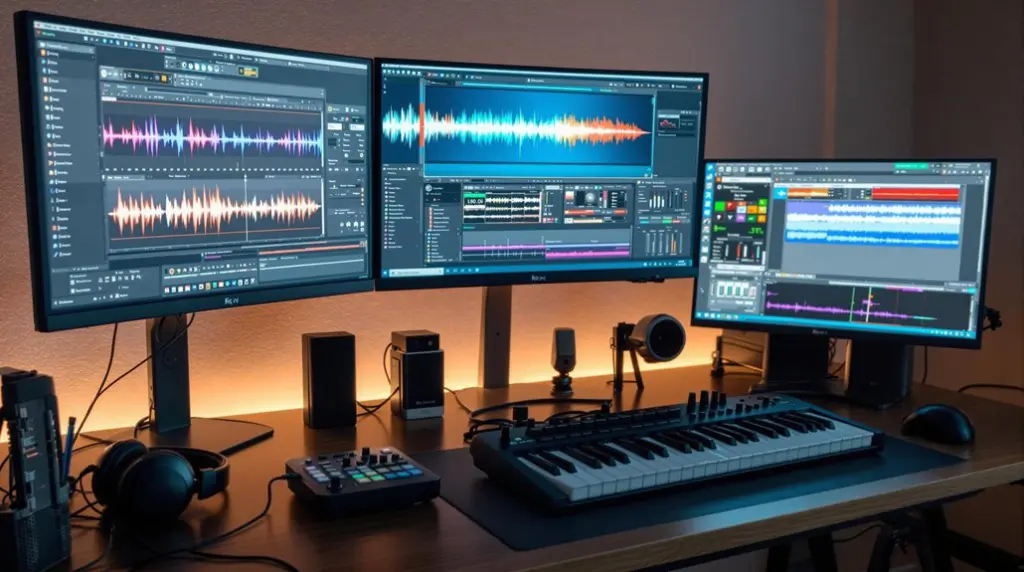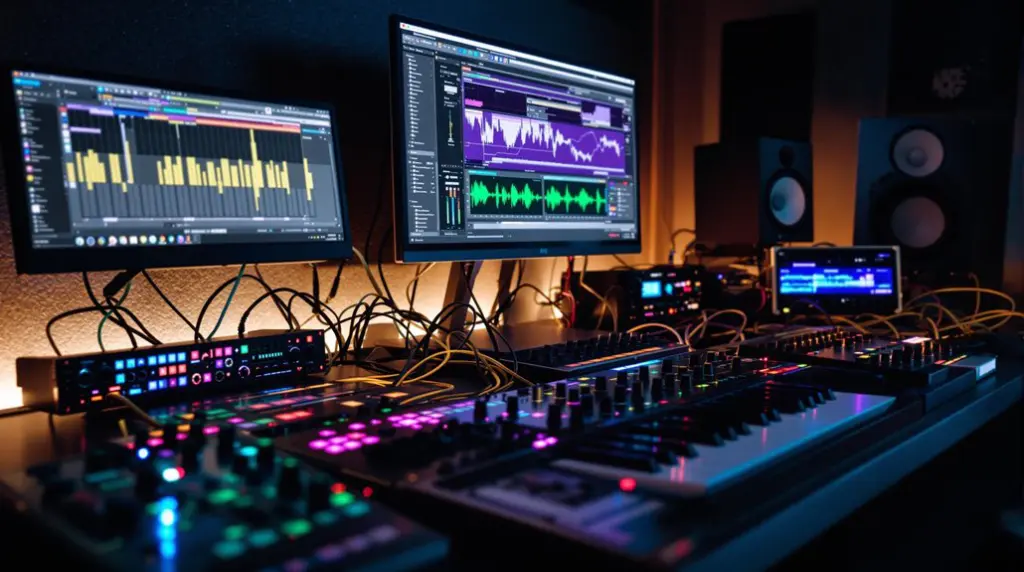The Moog Subharmonicon stands out with its dual primary oscillators and sub-harmonic generators, creating rich, multi-layered soundscapes. Its polyrhythmic sequencing, supported by two four-step sequencers and a 32-note capability, enables intricate rhythmic patterns. The extensive 32-point patchbay offers flexible signal routing, essential for advanced modular synthesis. Despite lacking internal LFOs, it excels in integrating external modulation sources, enhancing its sound design potential. The user-friendly interface, featuring 33 tactile knobs and 21 buttons, simplifies navigation. The active community guarantees robust support and ongoing development. With these standout features, there’s much more to uncover about this compact synth.
Key Takeaways
- The Subharmonicon’s unique “burn” sound is achieved through phase locking at odd subdivisions, creating distinct tonal qualities.
- Two four-step sequencers and a 32-note sequencer enable intricate polyrhythmic sequencing and complex rhythmic patterns.
- Extensive 32-point patchbay supports flexible routing and integration with external modulation sources for dynamic sound design.
- The semi-modular design allows standalone operation or seamless integration with other Eurorack modules.
- A 24dB/octave low-pass ladder filter with adjustable cutoff and resonance provides precise sound shaping capabilities.
Unique Sound Generation
Exploring the unique sound generation capabilities of the Moog Subharmonicon reveals a sophisticated synthesis architecture that sets it apart from conventional synthesizers. Central to its design are two primary oscillators, each augmented by two sub-harmonic generators. This structure allows for intricate sub harmonic layering, producing rich, multi-textured sounds that are both complex and sonically engaging.
The integration of essential mastering techniques like dynamic control through compression and EQ can further enhance the Subharmonicon’s output.
The Subharmonicon offers three distinct waveform options—sawtooth, square, and hybrid mode—each providing a unique palette for waveform exploration. These waveforms can be meticulously sculpted using the 24dB/octave low-pass ladder filter, which features adjustable cutoff and resonance controls. This filter enhances the synthesizer’s sound shaping capabilities, enabling users to create everything from subtle, warm tones to aggressive, resonant timbres.
Additionally, the Subharmonicon supports Pulse Width Modulation (PWM) through external Low-Frequency Oscillators (LFOs), further expanding its versatility. This allows for dynamic modulation of waveforms, adding an extra layer of depth and movement to the sound.
Another standout feature is its “burn” sound, achieved by perfect phase locking at odd subdivisions, imparting a distinctive tonal quality that is difficult to replicate with other synthesizers. This combination of features makes the Moog Subharmonicon a powerful tool for any sound designer.
Polyrhythmic Sequencing
Polyrhythmic sequencing within the Moog Subharmonicon is a cornerstone of its innovative design, providing a sophisticated framework for complex rhythmic patterns. This capability is driven by two four-step sequencers that control both fundamental and sub-harmonic pitches, enabling profound polyrhythmic exploration.
These sequencers can be manipulated through a quantizer that supports chromatic and diatonic scales, ensuring versatility across diverse musical temperaments. The master clock of the Subharmonicon, with a tempo range from 1/3Hz to 50Hz, underpins the intricate timing manipulation essential for polyrhythmic exploration.
By employing integer division of the master clock frequency, users can generate complex, evolving rhythms. The Polyrhythm section, equipped with four potentiometers, allows for the precise adjustment of integer values, facilitating the creation of unique rhythmic patterns. Understanding relationships between different rhythmic values is vital in mastering this feature.
Key features that enhance polyrhythmic sequencing include:
- Two four-step sequencers: Allowing control over fundamental and sub-harmonic pitches.
- Quantizer settings: Supporting chromatic and diatonic scales for diverse temperaments.
- Master clock: Providing extensive tempo range and integer division for intricate rhythms.
- Polyrhythm section: Four pots enabling detailed manipulation of rhythmic values.
In essence, the flexible routing of sequencers invites users to investigate sequencer manipulation, crafting intricate compositions that stand as a proof of the Subharmonicon’s extraordinary rhythmic capabilities.
Modulation and Integration
The Moog Subharmonicon’s extensive patchbay and its ability to act as a 60HP Eurorack module position it as a pivotal tool for modular synthesis enthusiasts, offering unparalleled routing flexibility.
The absence of internal LFOs necessitates the innovative use of external modulation sources, fostering a deeper exploration of dynamic soundscapes.
External Modulation Sources
Integrating external modulation sources with the Moog Subharmonicon opens a domain of sonic possibilities, bridging the gap between traditional sound synthesis and complex, evolving textures.
Due to the absence of internal LFOs, the Subharmonicon relies on external devices to augment its modulation techniques, providing users with a richer palette for sound manipulation. The patchbay offers extensive routing options, allowing modulation signals to be creatively assigned to various parameters such as pitch, filter cutoff, and more.
The hands-on approach fostered by this setup encourages experimentation with different external devices, leading to unique textures and dynamic changes. This semi-modular format seamlessly integrates with other Eurorack modules, enhancing its versatility within a broader modular ecosystem.
Users can employ a myriad of external effects and modulation sources to add layers of complexity, making it easier to achieve intricate sonic landscapes.
- Versatile Modulation Techniques: Experiment with various external devices to create distinctive modulations.
- Extensive Routing Options: Utilize the patchbay to route modulation signals creatively.
- Enhanced Sound Complexity: Add unique textures through external modulation sources.
- Seamless Eurorack Integration: Incorporate the Subharmonicon into your modular setup for expanded functionality.
This flexibility elevates the Subharmonicon from a standalone synthesizer to a pivotal component in a complex modular system.
Patchbay Routing Flexibility
Exploration of the Moog Subharmonicon‘s patchbay routing flexibility reveals a domain of intricate modulation and seamless integration capabilities. Central to this is the 32-point patch bay, which offers a vast array of signal flow and routing techniques that empower users to sculpt complex sonic landscapes.
By leveraging the patch bay, one can connect various modulation sources and effects, thereby revealing diverse textures and dynamic soundscapes. The ability to integrate external LFOs and other modulation sources through the patch bay greatly expands the Subharmonicon’s modulation palette.
The inclusion of both CV (control voltage) and gate signals guarantees that the Subharmonicon can seamlessly interface with other modular synths and Eurorack devices, enhancing its versatility in a modular setup. Users can assign different functions to the patch bay connections, facilitating unique and personalized routing configurations that can dramatically influence the synthesizer’s sound and responsiveness.
Moreover, the routing flexibility extends to the creation of intricate polyrhythmic patterns by manipulating clock signals and sequencers. This capability fosters creative exploration, allowing users to probe into complex rhythmical structures and innovative sound design.
The Subharmonicon’s patchbay is therefore a powerful tool for any sound designer seeking to push the boundaries of modular synthesis.
User-Friendly Interface
The Moog Subharmonicon’s user-friendly interface is a demonstration of intuitive control, featuring 33 knobs and 21 buttons that offer immediate tactile engagement with the instrument’s core functions.
Its front panel, divided into distinct sections for sequencers, oscillators, and filters, facilitates an organized and comprehensible workflow, while the 32-point patch bay enables sophisticated yet simplified signal routing.
Additionally, the inclusion of cardboard overlays bridges the learning curve, ensuring both novice and experienced users can quickly harness the synthesizer’s full potential.
Intuitive Control Layout
Maneuvering the Moog Subharmonicon’s front panel is an exercise in intuitive design, guaranteeing that even complex soundscapes are within easy reach. The user experience is markedly enhanced by the well-organized layout, which separates sequencers, oscillators, and filters into distinct sections.
This clear demarcation allows for swift navigation and manipulation during live performances, a vital aspect for both studio musicians and live performers.
The tactile feedback provided by the 33 knobs and 21 buttons guarantees that users can engage with essential parameters directly, eschewing the need for cumbersome menu diving. This hands-on approach is further complemented by the two four-step sequencers, each equipped with bipolar pots and LEDs, making real-time visualization and modification of sequencing patterns remarkably straightforward.
- User experience: Clear sectioning for sequencers, oscillators, and filters.
- Tactile feedback: 33 knobs and 21 buttons for direct parameter control.
- Sequencer clarity: Bipolar pots and LEDs for easy real-time adjustments.
- Beginner-friendly: Cardboard overlays to guide initial sound settings.
Incorporating a 32-point patch bay, the Subharmonicon extends its flexibility, allowing users to craft intricate signal routing and modulation setups intuitively.
This makes it a powerful yet approachable tool for sound design.
Simplified Patch Routing
Building upon the intuitive control layout, the Subharmonicon‘s simplified patch routing further enhances its accessibility and creative potential. Central to this design is the 32-point patch bay, which enables users to engage in patch point exploration without the intimidating complexity often associated with modular synthesis. Every patch point is clearly labeled, guaranteeing that even novice users can navigate the signal paths effortlessly.
The front panel’s organized sections for oscillators, filters, and sequencers streamline the routing experimentation process. Users can quickly identify and connect the necessary modules to sculpt their desired sounds. This sectioned layout not only facilitates a logical workflow but also encourages users to explore deeper into the sonic possibilities of the Subharmonicon.
Moreover, the semi-modular design offers versatility. Users can operate the Subharmonicon as a standalone unit or integrate it with other modular systems, expanding its creative capabilities.
The color-coded patch bay, coupled with thorough documentation, demystifies the routing process, making it more approachable for beginners. This user-friendly interface guarantees that both seasoned synthesists and newcomers can fully harness the potential of the Subharmonicon, fostering an environment of limitless sonic experimentation.
Community and Support
A thriving ecosystem surrounds the Moog Subharmonicon, where enthusiasts and experts alike converge to discuss an array of topics from intricate sound design to advanced recording techniques. This vibrant community engagement is a cornerstone of the Subharmonicon experience.
Users often share testimonials highlighting their journey with the instrument, revealing how it integrates seamlessly with other gear, thereby fostering a collaborative and creative atmosphere. Additionally, the community frequently explores high-quality content creation, such as curated mixes and event footage, to enhance their engagement and showcase their musical prowess.
Key elements of this dynamic community include:
- Dedicated forums: These platforms are a treasure trove of knowledge, where users exchange tips on sound design, troubleshooting MIDI functionality, and sequencer bugs.
- User-generated content: Tutorials and reviews help newcomers overcome the learning curve associated with the Subharmonicon’s complex features.
- Collaborative projects: Musicians often team up for experimental compositions, showcasing the instrument’s versatility.
- Influence on product development: Regular feedback from users has led to firmware updates, improving MIDI integration and overall usability.
Creative Potential
Engaging deeply with the Moog Subharmonicon community not only fosters collaboration but also sets the stage for exploring the instrument’s immense creative potential. The Subharmonicon’s dual oscillator design and 32-note sequencer provide a rich foundation for sound exploration. These features enable users to investigate experimental techniques, producing everything from deep bass tones to intricate harmonic textures. The ability to manipulate integer values for polyrhythmic sequencing further enhances compositional creativity, offering a unique approach to rhythm creation.
The extensive modulation options and high-quality analog filters allow for a broad range of sonic possibilities, from unique leads to complex pads. The built-in trigger button encourages spontaneous sound manipulation, which is integral for improvisation. Users are challenged to create their own sound design techniques due to the absence of presets, fostering a deeper connection with the synthesizer’s capabilities.
| Feature | Benefit | Creative Outcome |
|---|---|---|
| Dual Oscillator Design | Rich, complex soundscapes | Deep bass tones, harmonic textures |
| 32-Note Sequencer | Polyrhythmic sequencing | Enhanced compositional creativity |
| Extensive Modulation Options | Broad range of sounds | Unique leads, complex pads |
| Built-in Trigger Button | Spontaneous exploration | Immediate sound manipulation |
| No Presets | Encourages experimentation | Development of unique sound design |
Performance Capabilities
When evaluating the performance capabilities of the Moog Subharmonicon, one must consider its meticulously designed sequencer, which features two rows with four steps each, enabling the creation of intricate polyrhythmic patterns. This capability is pivotal for live interaction, allowing artists to manipulate sequences in real-time, thereby enhancing performance dynamics.
The Subharmonicon’s extensive modulation options provide control over oscillators, filters, and effects, which can be adjusted on-the-fly to create evolving soundscapes. For those interested in seamless integration, the synthesizer’s ability to sync seamlessly with external devices guarantees cohesive live setups.
Furthermore, its lightweight and compact design guarantees portability, making it an ideal choice for musicians who perform in diverse settings without compromising sound quality.
Its ability to sync seamlessly with external devices guarantees cohesive integration into live setups, supporting the creation of complex rhythms and harmonies. One of the standout features is the unique “burn” sound, produced through phase locking at odd subdivisions, which adds a distinctive character to live performances that is challenging to replicate with other instruments.
Key performance capabilities include:
- Intricate polyrhythmic patterns: Enabled by dual-row sequencer.
- On-the-fly modulation: Real-time control over oscillators, filters, and effects.
- Portability: Lightweight and compact design.
- Seamless integration: Syncs with external devices for cohesive performances.
Frequently Asked Questions
What Does the Subharmonicon Do?
The Moog Subharmonicon excels in subharmonic synthesis, generating complex harmonic textures through its dual oscillators. It also enables intricate polyrhythmic patterns via a built-in sequencer, offering extensive modulation and sound shaping capabilities for versatile audio exploration.
Does Moog Subharmonicon Have Midi?
Yes, the Moog Subharmonicon boasts robust MIDI capabilities, allowing for extensive MIDI integration. It supports MIDI sequencing and MIDI control, enhancing its versatility in complex setups and ensuring seamless interaction with other MIDI-enabled instruments and devices.
What Voltage Is the Moog Subharmonicon?
The Moog Subharmonicon operates on a 12-volt power supply, ensuring reliable performance for its analog synthesis. Its modulation capabilities are enhanced with CV ranges from -5V to +5V, facilitating extensive and versatile routing options.
How Do You Fine Tune a Subharmonicon?
Fine-tuning a Subharmonicon involves precise subharmonicon tuning through manual oscillator pitch adjustments and resonance adjustment. Employing external tuning devices enhances accuracy, ensuring harmonic coherence, especially after temperature fluctuations or prolonged usage, to maintain ideal sound stability.
Conclusion
The Moog Subharmonicon presents an innovative approach to sound synthesis through its unique sound generation, polyrhythmic sequencing, and extensive modulation capabilities. Its user-friendly interface and robust integration options facilitate seamless creativity and performance. The active community and ample support further enhance its usability, making it a powerful tool for both novice and experienced synthesists. Ultimately, the Subharmonicon stands out as a versatile instrument, offering immense creative potential and sophisticated performance capabilities.




